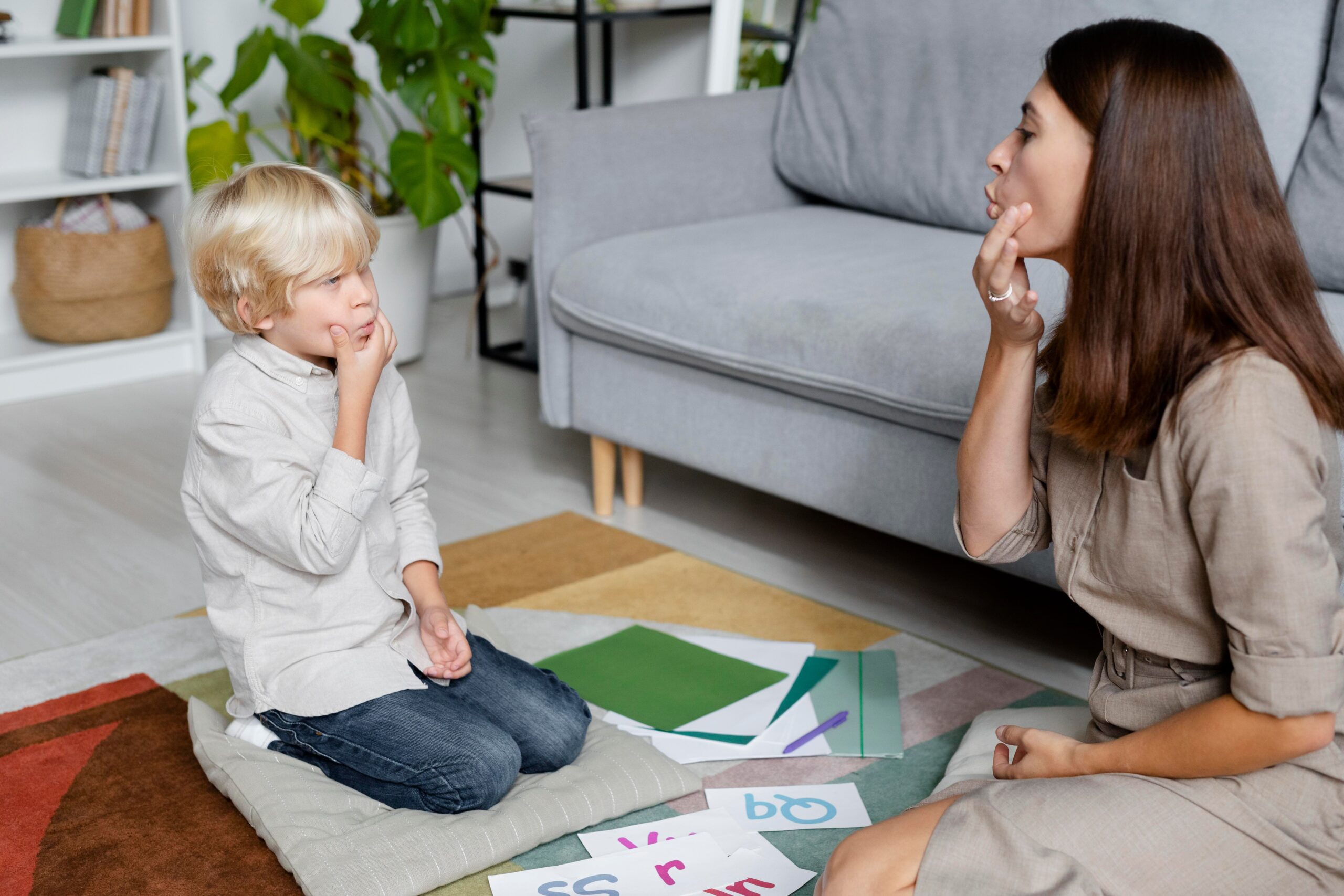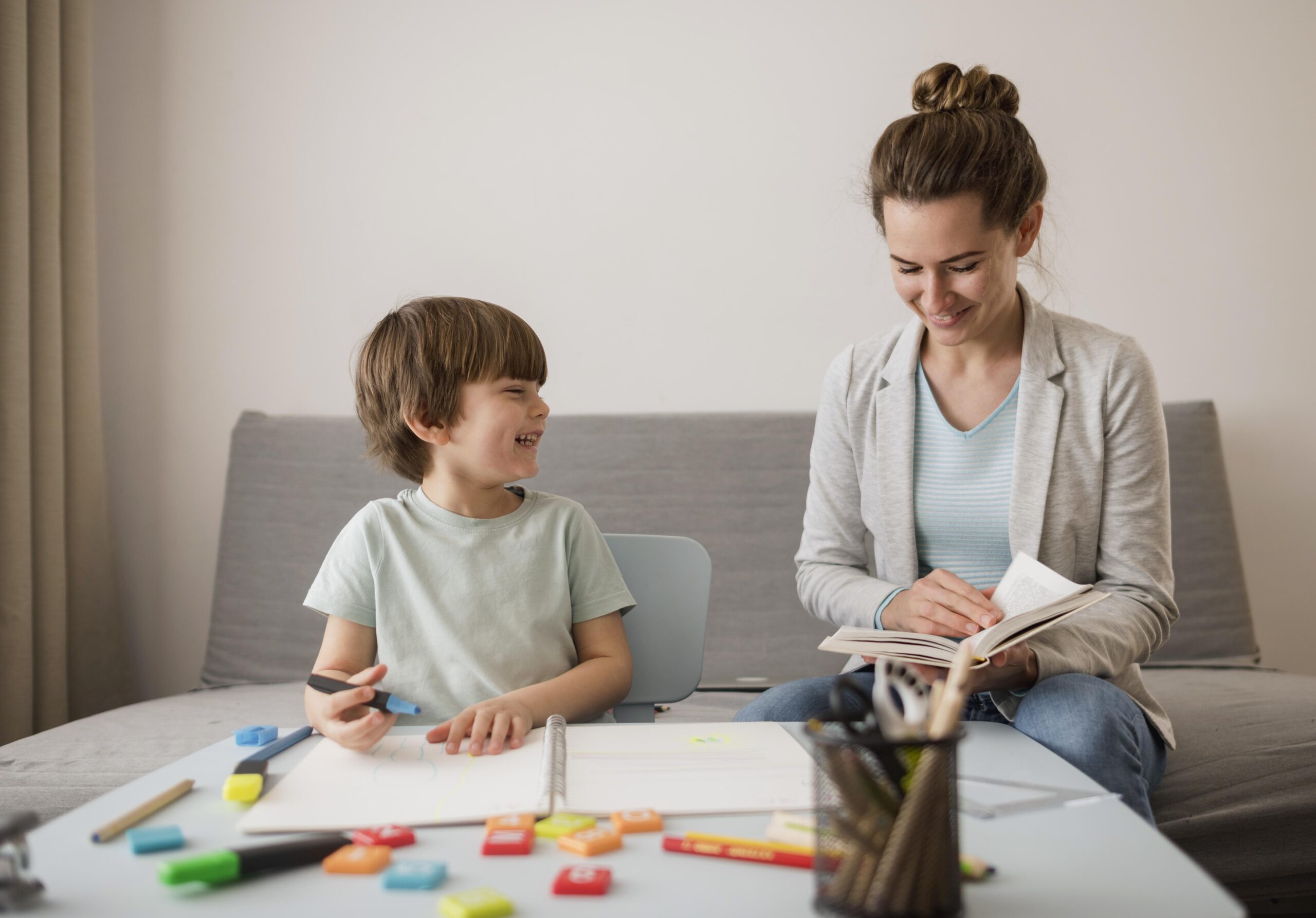Key Points:
- Autism language goals should be specific, measurable, and tailored to each child’s communication needs.
- Goals often target expressive, receptive, and social communication skills.
- A mix of structured therapy and natural interactions helps children generalize skills.
Why Speech and Language Goals Matter for Children with Autism
Many children with autism face challenges in communication. Some may struggle to express their needs, while others find it difficult to understand spoken language or engage in social conversations.
Parents often wonder what goals to focus on in speech therapy. The answer depends on each child’s strengths, challenges, and developmental stage. The right autism language goals can make everyday interactions easier and open the door to independence, friendships, and learning.
Speech and language goals are more than therapy checklists. They represent stepping stones that help children connect with the world around them.
How Speech and Language Development Differs in Autism
Children with autism may develop language differently than their peers. Some children remain nonverbal but communicate through alternative methods, while others may speak but struggle with social aspects of communication.
Common challenges include:
- Limited vocabulary or difficulty forming sentences.
- Echolalia, or repeating words and phrases without flexible use.
- Trouble understanding instructions or abstract language.
- Difficulty with back-and-forth conversations.
- Limited use of nonverbal cues like eye contact or gestures.
Speech and language therapy addresses these challenges by setting targeted goals that match the child’s needs.
Categories of Autism Language Goals
Expressive Language Goals
These goals help children learn to communicate their thoughts, wants, and needs. Examples include:
- Using single words, then progressing to short phrases.
- Expanding vocabulary to include action words and descriptive words.
- Building complete sentences using correct grammar.
- Learning to ask for help or request items appropriately.
Receptive Language Goals
Receptive goals focus on a child’s ability to understand and respond to language. Examples include:
- Following one-step and then multi-step directions.
- Identifying objects, actions, or pictures when named.
- Understanding concepts such as “under,” “behind,” or “next to.”
- Answering simple yes/no and “wh” questions.
Pragmatic (Social) Language Goals
Social communication is often an area of need for children with autism. Goals may include:
- Initiating conversations with peers.
- Maintaining eye contact during communication.
- Taking turns while speaking.
- Understanding tone of voice or facial expressions.
- Practicing greetings and farewells in social settings.
Alternative and Augmentative Communication (AAC) Goals
Some children may benefit from AAC, such as picture exchange systems or speech-generating devices. Goals here could include:
- Using a picture card to request a preferred toy.
- Navigating a communication app to express needs.
- Combining AAC symbols into short sentences.
Examples of SMART Autism Language Goals
Setting goals that are Specific, Measurable, Achievable, Relevant, and Time-bound ensures progress can be tracked. Here are some examples:
- Expressive goal: Within three months, the child will independently use 2- to 3-word phrases (e.g., “want juice”) to request preferred items in 4 out of 5 opportunities.
- Receptive goal: Within six weeks, the child will correctly follow two-step instructions (e.g., “Get the ball and put it on the chair”) with 80% accuracy.
- Pragmatic goal: Within three months, the child will take at least two conversational turns with a peer during structured play in 3 out of 5 sessions.
- AAC goal: Within eight weeks, the child will use a speech-generating device to make at least five requests per session.
These examples demonstrate how goals are tailored to specific needs and tracked over time.
How Therapists Develop Autism Language Goals
Speech-language pathologists (SLPs) often collaborate with families, teachers, and behavior analysts to develop meaningful autism language goals. The process usually involves:
- Assessment: Evaluating current skills through observation, standardized testing, and parent input.
- Prioritization: Identifying goals that will have the biggest impact on daily life.
- Customization: Adapting goals to fit the child’s learning style and environment.
- Ongoing review: Regularly monitoring progress and adjusting goals as needed.
Family involvement is key. When parents and caregivers understand the goals, they can reinforce skills at home and in the community.
Practical Examples of Speech and Language Goals in Action
To make the idea of autism language goals more concrete, let’s look at some practical scenarios.
- At home: A child is encouraged to say “milk, please” instead of crying when thirsty. Over time, this expands to “I want milk, please.”
- At school: A child learns to raise their hand and say, “I need help” instead of leaving their seat.
- In social play: A therapist models how to greet a peer by saying, “Hi, want to play?” and helps the child practice turn-taking.
- With AAC: A child presses icons on a device to say, “I want swing” when at the playground.
These real-life applications show how goals translate into daily improvements.
Strategies to Support Autism Language Goals
- Use visual supports: Picture schedules, flashcards, and visual prompts help children understand and use language.
- Incorporate interests: Building goals around a child’s favorite toys or activities keeps them motivated.
- Practice in natural settings: Skills are easier to generalize when practiced at the park, grocery store, or during family routines.
- Reinforce progress: Praise, tokens, or small rewards can encourage children to use new skills consistently.
- Model language: Caregivers and therapists can model appropriate words and sentences in everyday contexts.
Common Challenges with Autism Language Goals
Even with strong goals in place, progress may not always be linear. Some challenges include:
- Plateaus in learning: A child may master a skill but take longer to move to the next step.
- Difficulty generalizing: A child might use a skill in therapy but not at home.
- Behavioral barriers: Frustration or sensory sensitivities can sometimes interfere with communication.
Therapists address these challenges by breaking goals into smaller steps, offering more practice opportunities, and adjusting teaching methods.
Parent Tips for Supporting Speech and Language Goals at Home
- Build language into routines. For example, practice naming foods during mealtime.
- Encourage choices. Offer two options (“Do you want apple or banana?”) to promote decision-making.
- Pause strategically. Give your child time to respond instead of filling in the words for them.
- Celebrate small wins. Acknowledge even small improvements to keep your child motivated.
- Stay consistent. Use the same cues and prompts that therapists use for continuity.
Parents play a powerful role in reinforcing autism language goals outside therapy sessions.
 Frequently Asked Questions About Autism Language Goals
Frequently Asked Questions About Autism Language Goals
Do all children with autism need speech goals?
Not every child, but many benefit from structured language goals, whether through spoken words, AAC, or both.
How soon can I expect progress?
Progress depends on the child’s starting point, the intensity of therapy, and how consistently goals are practiced. Some skills build quickly, while others take time.
Can nonverbal children still benefit from speech therapy?
Yes. Speech therapy for nonverbal children often focuses on AAC, gestures, or other communication methods to give them a voice.
How do autism language goals connect with ABA therapy?
ABA therapy often incorporates communication goals into behavior programs, reinforcing speech and language skills in structured and natural settings.
Pulling It All Together
Autism language goals provide children with a roadmap for building communication skills that make life easier and more fulfilling. From expressing basic needs to holding conversations, these goals grow with the child and adapt to their progress.
Parents, therapists, and teachers working together can ensure goals are meaningful, measurable, and practical. While challenges may arise, the right strategies and consistent practice lead to real improvements in daily communication.
If you are looking for professional guidance in setting and achieving autism language goals, Spirit ABA can help. With ABA therapy services in Nebraska, Colorado, and Iowa, our team collaborates with families to create personalized therapy plans that include communication goals. By combining evidence-based strategies with meaningful practice, ABA therapy with Spirit ABA can help your child build stronger language skills and greater independence.
Start today by exploring how tailored ABA therapy services in your area can support your child’s communication journey. Contact us so we can answer your questions!



